@ALL ACERS
Here are some of the detailed information about the Treks that we had. Below are the pictures
and collated data of the Places and Fauna that we have encountered on our treks. Please
do help me make some corrections, additions or suggestions before we get this printed out.
I will do this one at a time so please bear with me. Please do help me check for spelling error..
FIRST ACE TREK
LOCATION: GUADALUPE RIVER
DATE: September 07, 2008
This is the very first trek that was done by the ACE members. It rained during this trek,
but the trek continued throughout the day. Despite the human population, the river still
has a few flora and fauna that's surviving although some are introduced species.
FAUNA:
Common Name: Kawa-anago - in Japan
Scientific Name: Eleotris oxycephala
Local Name:
General Description:
This goby species belongs to the Eleotridae family, also known as the Sleepers and has a
lot of related species under the same genus that would sometimes, cause confusions
among hobbiests. This is a predatory fish and should not be kept with smaller tankmates.
This fish will readily consume any small fish, crustaceans and even insects.
Environment:
This fish is believed to acclimatize on freshwater, brackish and even on a marine
environment. The fish is generally demersal and will spend most of its time at the bottom.
Status: Native Species
Origin:
The Philippines. Japan, Mainland China, Korea and Viet Nam
Common Name: Asian Walking Catfish or Thai Catfish
Scientific Name: Clarias batrachus
Local Name: Pantat
General Description:
This Catfish species is one of those that can breathe athmospheric air and is a survival artist
that can survive prolonged exposure to dried up rivers and lakes. This species is now being
hybredized by aquaculturist to it's african relative the African Walking Catfish (Clarias gariepinus)
as a result, this species is considered rare to it's original habitat. This fish will eat insects, worms
and anything that's edible.
Environment:
Can live in Freshwater and Brackish environment and can live in muddy water and
at one point, will walk it's way to migrate to another pool or river.
Status:
A highly invasive introduced species and is considered a threat to the local aquatic Fauna.
This species was introduced to Mainland China, Guam, Japan, Papua New Guinea, Taiwan, Philippines
and even in the USA
Origin:
Native to Bangladesh, Cambodia, India, Indonesia, Laos, Malaysia, Myanmar, Nepal, Pakistan,
Singapore, Sri Lanka, Viet nam and Thailand.
Common Name: Wild Guppy or Mosquito fish
Scientific Name: Poecilia reticulata
Local Name: Isda-Sapa
General Description:
Considered to be the smallest among all the live-bearing toothcarps. The wild guppy was once
considered Fancy during the early times of the aquarium industry and is now being regarded as
econimically worthless and is now on the top of the list of feeder fishes. On the flip side, some
wild guppy males and females are being used to breed with Fancy guppies to produce more strain
that catches the eye of guppy collectors.
Environment: Can acclimatize in fresh but best kept in a semi brackish environment.
Status: Introduced worldwide mainly for mosquito control. This species has no negative nor neutral
impact to the local Fauna but may have competed for food with our local egg-laying toothcarp.
Origin: Venezuela, Barbados, Trinidad, Northern Brazil and the Guyanas
.
Results 31 to 40 of 193
-
12-02-2009, 05:07 PM #31
-
12-02-2009, 05:43 PM #32
-
12-02-2009, 10:43 PM #33
Fauna #9 : Discus Fish

Common Name: Discus Fish
Scientific Name: Symphysodon aequifasciatus, Symphysodon discus, Symphysodon haraldi
Local Name: Discus Fish
Origin: Brazil, Columbia, Peru
Life Span:
Temperament:
Tank Compatibility Issue (for both Flora and Fauna): If you are going to have plants you can either use plastic plants or live plants. I personally don’t like or use plastic plants but it is down to your personal preference. Lately, silk plants have become all the rage and they look much more realistic than plastic, which would add to the aesthetics of the aquarium. Rams are also a favorite to keep with Discus Aquarium Fish. Many had success with dwarf gouramis as well as pearls, though the blue and golden gouramis are bullies and should be avoided. When you get young Discus Aquarium Fish make sure you get a shoal as like other fish they need the security of a shoal around them.
Freshwater/Brackish/Marine: Freshwater
Water pH:
Display – 6.5 – 7.5
Breeding – 5.5 – 6.5
Growing On – 6.8 – 7.5
Water Hardness: general (GH) and carbonate (KH)
Schooling/Non-schooling: schooling
Common Illness/Problems: ich, poor diet,bullying,parasites.
Growth: Fast, depends on the care
Length/Size: 20-25cm (8-10”)
Difficulty: Easy to Medium
Water Current/Movement Issues:
General Description:
The discus is a social fish and lives in large groups in their native waters, and has a very advanced social behaviour; they are one of the few real schooling cichlids. Remember to keep this in mind when starting care for discus; always purchase a group of animals. They need the social interaction to develop their character to its best potential.
Currently, it is becoming increasingly difficult to find the original colour variants in pet shops, only the Heckel is sometimes imported. Most of the discus fish you encounter today are captive bred colour variants. At this time the list of described colour variants is nearly endless. Some of the discus colour variants have lost their stripes and therefore their natural ability to communicate in the school. But as always these new variants are finding their way to the aquarium hobbyist quickly for exceptionally high prices and this will stimulate the breeders to try to find a new one. One of the advantages of the captive bred discus is that they are now much easier, not easy, to maintain as the imported ones. They are much more tolerant concerning water conditions.
Other Important Information:
There are plenty of strains of Discus Aquarium Fish available on the market now but all originate from the same species Symphysodon aequifasciatus. In the 80’s the Germans were the first to develop the blue varieties and other colours and varieties, but now east Asia develops some fascinating strains like Snow Whites, White Dragons, Pandas, which most are particular fan of, as well as the Snakeskin, Thunder Flashes, Checkerboards etc.
New strains are been developed all the time and there is now getting a vast variety. However, some enthusiast would recommend the beginner stick’s to the classic strains like Red Turquoise and Blue turquoise, as these fish tend to be hardier and a little bit less fussy.
If you are buying young fish ask to see the parents or adult fish of that strain to make sure you know what you are getting. Most breeders or importers will be able to let you do this as they tend to stock the same strains of young and adults.
If you want a solid blue colour,the highly recommend are the Blue Diamond or Cobalt Blue, and if you want a solid red then go with a Red Melon or Marlboro Red. If you want striped or patterned fish then go with snakeskin or pigeon bloods. There are also Tefe Greens which are recommended for advanced hobbyists, as well as Heckels and wild specimens, which should really be attempted by those individuals who have their hobby down to a science.
References:
Discus Aquarium Fish
discus.jpg picture by moy1moy1 - Photobucket
http://en.wikipedia.org/wiki/Discus_fish
-
12-03-2009, 12:31 PM #34
Fauna #10 : Red-Eared Slider

Common Name: Red-Eared Slider
Scientific Name: Trachemys scripta elegans
Local Name:
Red-Eared Slider, Red-Eared Terrapin, Terrapin(in petshops), green turtle (in petshops)
Origin:
Native in Southern United States but due to pet trade, its common in several rivers around the globe
Life Span: Individuals of this species have lived at least 35 years in captivity.
Temperament: Timid, Semi-Aggresive , Most are Docile in nature.
Tank Compatibility Issue (for both Flora and Fauna):
Freshwater/Brackish/Marine:
Water pH:
Water Hardness:
Schooling/Non-schooling: Non-schooling
Common Illness/Problems:Turtles may not be as sensitive to chlorine as fish or amphibians, but it can still be irritating to them (especially their eyes).Maintaining good water quality is an important aspect of keeping turtles healthy. Other problems include: cloudy water, agitation, diet of inappropriate foods, stress. Problems to the keeper: Be aware that pond turtles harbor salmonella bacteria, a kind of bacterium which is a threat to the keeper and its family.
Growth: Slow,depends on diet
Length/Size:
The female Red-eared Slider grows to be 25–30 cm (10–12 in) in length and males 20–25 cm (8–10 in)
Difficulty: Easy to Medium
Water Current/Movement Issues:
Description:
Red-eared Sliders are almost entirely aquatic, but leave the water to bask in the sun and lay eggs. These reptiles are deceptively fast and are also excellent swimmers. They hunt for prey and will attempt to capture it when the opportunity presents itself. They are very aware of predators and people and generally shy away from them. The Red-eared Slider is known to frantically slide off rocks and logs when approached.The carapace (top shell) is oval and flattened (especially in the male), has a weak keel that is more pronounced in the young, and the rear marginal scutes are notched. The carapace usually consists of a dark green background with light and dark highly variable markings. The plastron (bottom shell) is yellow with dark paired irregular markings in the center of most scutes. The plastron is highly variable in pattern. The head, legs, and tail are green with fine yellow irregular lines. Some dimorphism occurs between males and females. Male turtles are usually smaller than females but their tail is much longer and thicker. Claws are elongated in males which facilitate courtship and mating. Typically, the cloacal opening of the female is at or under the rear edge of the carapace while the male's opening occurs beyond the edge of the carapace. Older males can sometimes have a melanistic coloration being a dark grayish olive green, with markings being very subdued. The red stripe on the sides of the head may be difficult to see or be absent.
Other Important Information:
Red-eared Sliders are omnivores and eat a variety of animal and plant materials in the wild including, but not limited to fish, crayfish, carrion, tadpoles, snails, crickets, wax worms, aquatic insects and numerous aquatic plant species. The captive diet for pet Red-eared Sliders should be a varied diet consisting of feeder fish, aquatic plants and other natural foods. They should never be fed commercial dog food, cat food, nor fish chow or turtle food. Commercial turtle foods can be used sparingly and should not be used as the primary food. Calcium (for shell health) can be supplemented by adding pieces of cuttlebone to the diet, or with commercially available vitamin supplements. A nutritious food readily accepted by young turtles is baby clams soaked in krill oil covered with powdered coral calcium. Younger turtles tend to be more carnivorous (eat more animal protein) than adults do. As they grow larger and older, they become increasingly herbivorous. Live foods are particularly enjoyed and add to the quality of life of captive turtles. Providing a wide variety of foods is the key to success with captive Red-eared Sliders.Red eared sliders are not easy to s3x until they reach sexual maturity. You might also discover you have a female when she starts laying eggs (females will lay infertile eggs without a male present). While I don't recommend casual breeding of red eared sliders, providing a nesting area is important for egg laying females. Although they will lay eggs in water, this is not their preferred way and some females will retain their eggs rather than dropping them in water, which can be a serious health issue.
References :
Red Eared Sliders - Care of Red Eared Sliders
Red-eared slider - Wikipedia, the free encyclopedia
Red eared slider image by princer7 on Photobucket
-
12-04-2009, 07:07 PM #35
Flora #44: Hydrocotyle leucocephala
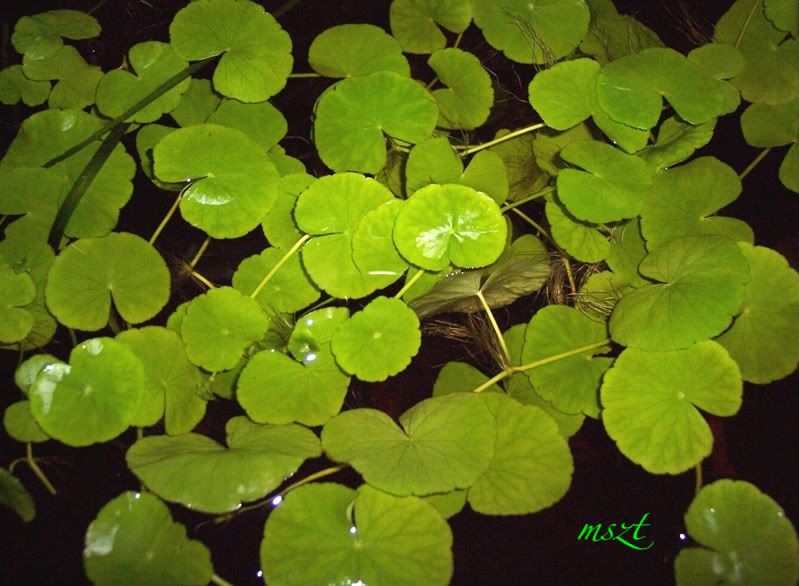
Common Name: Pennywort, Brazilian Water Ivy
Scientific Name: Hydrocotyle leucocephala
Local Name: Pennywort, Brazilian Water Ivy
Origin: South America
Native to Philippines (Y/N): N
Light Level: High to Very High
CO2 Requirement (Y/N): Y
Fertilizer Requirement (Y/N): Y
Life Span:
Freshwater/Brackish/Marine: Freshwater
Water pH: 6 - 8
Water Hardness:
Common Illness/Problems:
Growth: Fast
Length/Size: 50 - 60 cm
Difficulty: Easy
Tank Position: Midground, Foreground, Floating
Water Current/Movement Issues:
General Description:
This plant is similar in apperance to Cardamine lyrata although the leaves are much larger. It adapts to most aquarium conditions although it does appreaciate good lighting. If kept in low-light tanks growth is slower. Plant either in the substrate or as a floating plant. This is a very tropical and exotic looking plant with a beautiful shade of green. Hydrocotyle leucocephala does better with a nutrient rich water column and loves nitrogen.
Other Important Information:
Flora #45: Hydrocotyle verticillata

Common Name: Whorled Pennywort (not to be confused with gotu kola or Centella asiatica)
Scientific Name: HydrHydrocotyle verticillata
Local Name: Whorled Pennywort (not to be confused with gotu kola or Centella asiatica)
Origin: South America
Native to Philippines (Y/N): Y (introduced species)
Light Level: High to Very High
CO2 Requirement (Y/N): Y
Fertilizer Requirement (Y/N): Y
Life Span:
Freshwater/Brackish/Marine: Freshwater
Water pH: 5 - 7
Water Hardness:
Common Illness/Problems:
Growth: Slow
Length/Size: 5 - 7 cm
Difficulty: Hard
Tank Position: Midground, Foreground, Floating
Water Current/Movement Issues:
General Description:
Unlike other Hydrocotyle-species, this plant retains its trailing growth form. Optimum growth is only achieved in strong light and soft, slightly acidic water. It does not need to be rooted, but can be used as a floating plant. Hydrocotyle verticillata is defi nitely a foreground plant which can also be used in garden ponds. It can also be used as an indoor plant if the soil is kept moist.
Other Important Information:
Flora #46: Hygrophila corymbosa sp.
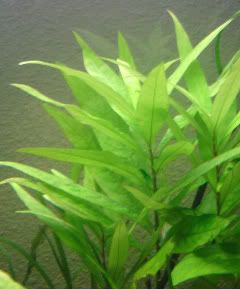
Common Name: Hygrophila corymbosa 'Angustifolia' (refer to Flora# 75), Hygrophila corymbosa 'Compact', Hygrophila corymbosa 'Red', Hygrophila corymbosa 'Siamensis', Hygrophila corymbosa 'Siamensis 53B'
Scientific Name: Hygrophila corymbosa
Local Name: Hygrophila corymbosa 'Angustifolia' (refer to Flora# 75), Hygrophila corymbosa 'Compact', Hygrophila corymbosa 'Red', Hygrophila corymbosa 'Siamensis', Hygrophila corymbosa 'Siamensis 53B'
Origin: Southeast Asia
Native to Philippines (Y/N):
Light Level: Medium to Very High
CO2 Requirement (Y/N): Y
Fertilizer Requirement (Y/N): Y
Life Span:
Freshwater/Brackish/Marine: Freshwater
Water pH: 5.5 - 8
Water Hardness:
Common Illness/Problems:
Growth: Medium
Length/Size: 15 - 50 + cm
Difficulty: Easy to Medium
Tank Position: Midground to Background
Water Current/Movement Issues:
General Description:
Under water Hygrophila corymbosa ‘Angustifolia’ has relatively narrow leaves which are grouped close together. Hygrophila corymbosa ‘Compact’ is a very compact variety of Hygrophila corymbosa, with the leaves set close to the stalk. Forms numerous side shoots, enhancing the compact appearance. Hygrophila corymbosa ‘Red’ is an undemanding plant for large aquariums, which thrives in almost any conditions. If it is not pruned it easily grows above the water surface. Hygrophila corymbosa ‘Siamensis’ grows easily above the water surface, where it forms blue-green leaves and small blue flowers. It grows fast and the shoots must be pinched out regularly if you want to keep the plant under water, and an extremely hardy plant, suitable for beginners.
Other Important Information:Last edited by gaevwa; 12-09-2009 at 08:13 AM.
-
12-04-2009, 07:35 PM #36
Flora #47: Hygrophila balsamica
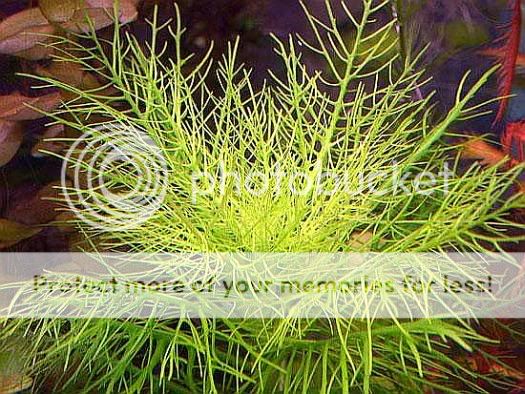
Common Name: Hygrophila balsamica
Scientific Name: Hygrophila balsamica
Local Name: Hygrophila balsamica
Origin: Sri Lanka, India
Native to Philippines (Y/N):
Light Level: Medium
CO2 Requirement (Y/N):
Fertilizer Requirement (Y/N): Y
Life Span:
Freshwater/Brackish/Marine: Freshwater
Water pH: 6 - 8
Water Hardness:
Common Illness/Problems:
Growth: Fast
Length/Size: 5 - 20 cm
Difficulty: Easy
Tank Position: Midground to Background
Water Current/Movement Issues:
General Description:
It is much more suitable for aquariums with abundant light and co2 than those with low light and little or no carbon dioxide supplementation, where its beautiful bright green and finely divided leaves will become less pinnate and lose size. Apart from those requirements and a need for a great deal of iron, it does not place any special demands on the grower and is not particularly susceptible to stunting or any other common problems.
Other Important Information:
If its emersed shoots are placed directly into an aquarium containing fish or invertebrates, the animals will be poisoned. However, the plant is not at all toxic in its submersed form and may be used without issue once submersed growth is obtained.
Flora #48: Hygrophila difformis

Common Name: Hygrophila difformis, wisteria
Scientific Name: Hygrophila difformis
Local Name: Hygrophila difformis, wisteria
Origin: Southeast Asia
Native to Philippines (Y/N):
Light Level: Medium to Very high
CO2 Requirement (Y/N): Y
Fertilizer Requirement (Y/N): Y
Life Span:
Freshwater/Brackish/Marine: Freshwater
Water pH: 5 - 9
Water Hardness:
Common Illness/Problems:
Growth: Fast
Length/Size: 20 - 50 cm
Difficulty: Easy
Tank Position: Midground to Background
Water Current/Movement Issues:
General Description:
Hygrophila difformis is beautiful and undemanding. A plant for beginners which can help create a balance in the aquarium from the start. Its rapid growth helps prevent algae because the plant absorbs a great number of nutrients from the water. The shortage of micro-nutrients leads to pale leaves, which may be an indication that the aquarium needs fertiliser. In large aquariums its lobed leaves can create a distinctive group.
Other Important Information:
Flora #49: Barclaya longifolia
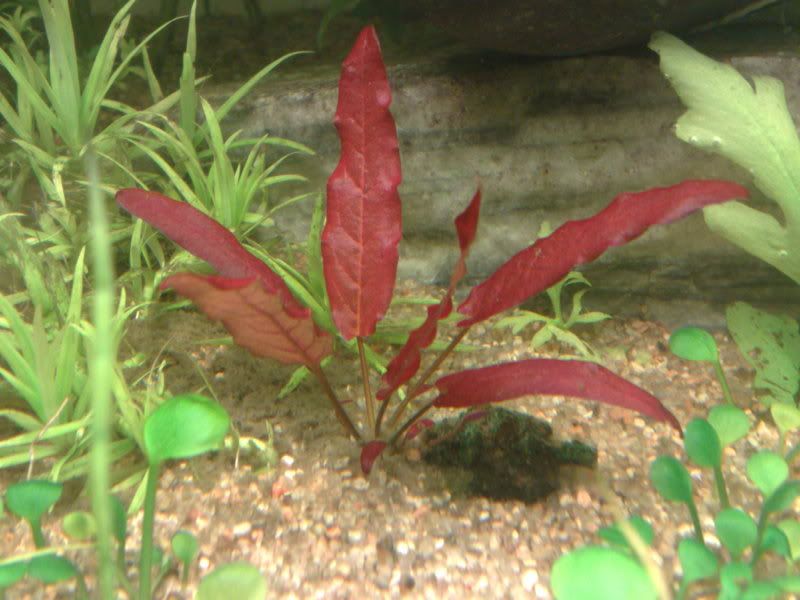
Common Name: Orchid Lily
Scientific Name: Barclaya longifolia
Local Name: Orchid Lily, Barclaya longifolia
Origin: Southeast Asia
Native to Philippines (Y/N):
Light Level: Medium to High
CO2 Requirement (Y/N):
Fertilizer Requirement (Y/N):
Life Span:
Freshwater/Brackish/Marine: Freshwater
Water pH: 6.3 - 7.2
Water Hardness:
Common Illness/Problems:
Growth: Medium to Fast
Length/Size: 30 - 80 cm
Difficulty: Easy
Tank Position: Midground to Background
Water Current/Movement Issues:
General Description:
This is a rhizome plant so propagation is merely a matter of dividing the rhizome into smaller pieces and then replanting these in the substrate. Take care not to completely bury the rhizome or it will rot.
Other Important Information:
If lower lighting levels are used, the leaves will change from a red to a green colour.Last edited by gaevwa; 12-09-2009 at 08:14 AM.
-
12-04-2009, 08:12 PM #37
Flora #50: Cryptocoryne crispatula 'balansae'

Common Name: Cryptocoryne balansae
Scientific Name: Cryptocoryne crispatula 'balansae'
Local Name: Cryptocoryne balansae
Origin: Thailand
Native to Philippines (Y/N):
Light Level: Low to Very High
CO2 Requirement (Y/N): N
Fertilizer Requirement (Y/N): N
Life Span:
Freshwater/Brackish/Marine: Freshwater
Water pH: 5 - 9
Water Hardness:
Common Illness/Problems:
Growth: Medium
Length/Size: 20 - 50 + cm
Difficulty: Easy
Tank Position: Background
Water Current/Movement Issues:
General Description:
Cryptocoryne crispatula var. balansae is the oldest known variety of Cryptocoryne crispatula. In the region it comes from in southern Thailand there are limestone mountains, and the water can be very hard. Like many other Cryptocoryne it needs to acclimatise before growth starts in earnest. In recent years a narrow-leaf variety called Cryptocoryne crispatula var. fl accidifolia has often been sold.
Other Important Information:
If the plant is affected by the so-called “cryptocoryne disease’’, “cryptocoryne melt" or “cryptocoryne rot", do not remove it from the aquarium because a few weeks later it will produce new shoots.
Flora #51: Cryptocoryne beckettii 'petchii'

Common Name: Cryptocoryne beckettii 'petchii'
Scientific Name: Cryptocoryne beckettii 'petchii'
Local Name: Cryptocoryne beckettii 'petchii'
Origin: Southeast Asia
Native to Philippines (Y/N):
Light Level: Low to Very High
CO2 Requirement (Y/N): N
Fertilizer Requirement (Y/N): N
Life Span:
Freshwater/Brackish/Marine: Freshwater
Water pH: 5 - 9
Water Hardness:
Common Illness/Problems:
Growth: Slow
Length/Size: 10 - 15 cm
Difficulty: Easy
Tank Position: Background
Water Current/Movement Issues:
General Description:
Cryptocoryne beckettii ‘’petchii’’ is a small variety of Cryptocoryne beckettii, which has beautiful, slightly fluted leaf margins. Like many other Cryptocoryne, the leaf colour and shape depends largely on environmental conditions in the aquarium.
Other Important Information:
If the plant is affected by the so-called “cryptocoryne disease’’, “cryptocoryne melt" or “cryptocoryne rot", do not remove it from the aquarium because a few weeks later it will produce new shoots.
Flora #52: Cryptocoryne parva
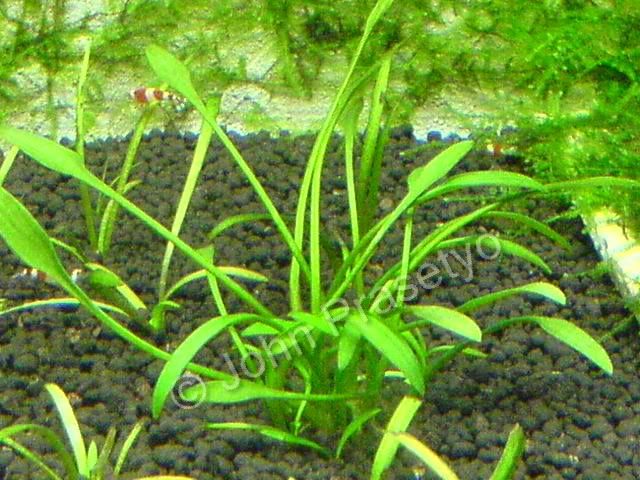
Common Name: Tiny cryptocoryne, Cryptocoryne parva
Scientific Name: Cryptocoryne parva
Local Name: Tiny cryptocoryne, Cryptocoryne parva
Origin: Sri Lanka
Native to Philippines (Y/N):
Light Level: Low to Very High
CO2 Requirement (Y/N): N
Fertilizer Requirement (Y/N): N
Life Span:
Freshwater/Brackish/Marine: Freshwater
Water pH: 5.5 - 8
Water Hardness:
Common Illness/Problems:
Growth: Slow
Length/Size: 5 - 10 cm
Difficulty: Medium
Tank Position: Mid-ground to Foreground
Water Current/Movement Issues:
General Description:
Cryptocoryne parva is the smallest of all Cryptocoryne. It is one of the few species that does not significantly change its leaf shape and colour depending on cultivation conditions. It needs more light than most other Cryptocoryne because it almost loses its leaf blade under water. So it must never be overshadowed by other plants. Individual plants should be planted a few centimetres apart, and after about six months they will form a cohesive low group of plants. Recommended for foreground planting.
Other Important Information:
If the plant is affected by the so-called “cryptocoryne disease’’, “cryptocoryne melt" or “cryptocoryne rot", do not remove it from the aquarium because a few weeks later it will produce new shoots.
Flora #53: Cryptocoryne undulata sp.

Common Name: Undulate cryptocoryne, Cryptocoryne undulata, Cryptocoryne undulata 'broad leaves'
Scientific Name: Cryptocoryne undulata
Local Name: Undulate cryptocoryne, Cryptocoryne undulata, Cryptocoryne undulata 'broad leaves'
Origin: India
Native to Philippines (Y/N):
Light Level: Low to Very High
CO2 Requirement (Y/N): N
Fertilizer Requirement (Y/N): N
Life Span:
Freshwater/Brackish/Marine: Freshwater
Water pH: 5.5 - 8
Water Hardness:
Common Illness/Problems:
Growth: Medium
Length/Size: 10 - 15 + cm
Difficulty: Easy
Tank Position: Mid-ground to Background
Water Current/Movement Issues:
General Description:
It is characteristic for this species that it has a small internodium between each leaf. Normally the leaves of Cryptocoryne grow out from a rosette which is so compact that the stem between the individual leaves is invisible. When you buy Cryptocoryne in pots, it is important that they are not planted in a lump but separated into smaller portions and preferably planted a few centimetres apart.
Other Important Information:
If the plant is affected by the so-called “cryptocoryne disease’’, “cryptocoryne melt" or “cryptocoryne rot", do not remove it from the aquarium because a few weeks later it will produce new shoots.
Flora #54: Cryptocoryne wendtii sp.

Common Name: Cryptocoryne wendtii 'brown', Cryptocoryne wendtii 'green', Cryptocoryne wendtii 'Mi Oya', Cryptocoryne wendtii 'Tropica'
Scientific Name: Cryptocoryne wendtii
Local Name: Cryptocoryne wendtii 'brown', Cryptocoryne wendtii 'green', Cryptocoryne wendtii 'Mi Oya', Cryptocoryne wendtii 'Tropica'
Origin: Sri Lanka
Native to Philippines (Y/N):
Light Level: Very Low to High
CO2 Requirement (Y/N): N
Fertilizer Requirement (Y/N): N
Life Span:
Freshwater/Brackish/Marine: Freshwater
Water pH: 5.5 - 8
Water Hardness:
Common Illness/Problems:
Growth: Medium
Length/Size: 5 - 20 + cm
Difficulty: Easy
Tank Position: Mid-ground to Background
Water Current/Movement Issues:
General Description:
This cryptocoryne can be used as mid-ground and background plants. Leaf color depends on number of factors, including lighting. Plant in spaced groups to allow spreading and creating dense clump.
Other Important Information:
If the plant is affected by the so-called “cryptocoryne disease’’, “cryptocoryne melt" or “cryptocoryne rot", do not remove it from the aquarium because a few weeks later it will produce new shoots.Last edited by gaevwa; 12-04-2009 at 09:03 PM.
-
12-04-2009, 09:03 PM #38
Flora #55: Cryptocoryne x willisii

Common Name: Cryptocoryne x willisii
Scientific Name: Cryptocoryne x willisii
Local Name: Cryptocoryne x willisii
Origin: Sri Lanka
Native to Philippines (Y/N):
Light Level: Low to High
CO2 Requirement (Y/N): N
Fertilizer Requirement (Y/N): N
Life Span:
Freshwater/Brackish/Marine: Freshwater
Water pH: 5.5 - 8
Water Hardness:
Common Illness/Problems:
Growth: Slow
Length/Size: 7 - 20 + cm
Difficulty: Easy
Tank Position: Mid-ground to Background
Water Current/Movement Issues:
General Description:
There is some confusion about the name of this plant. It used (mistakenly) to be called Cryptocoryne nevillii, but this is the name of a species that has never been used in aquariums. Like many other Cryptocoryne, not much happens the fi rst month after planting. But then it starts to grow, and willingly produces plenty of runners which form a compact group. See other Cryptocoryne for further information.
Other Important Information:
If the plant is affected by the so-called “cryptocoryne disease’’, “cryptocoryne melt" or “cryptocoryne rot", do not remove it from the aquarium because a few weeks later it will produce new shoots.
Flora #56: Cryptocoryne affinis

Common Name: Cryptocoryne affinis
Scientific Name: Cryptocoryne affinis
Local Name: Cryptocoryne affinis
Origin: Malaysia
Native to Philippines (Y/N):
Light Level: Low to High
CO2 Requirement (Y/N): N
Fertilizer Requirement (Y/N): N
Life Span:
Freshwater/Brackish/Marine: Freshwater
Water pH: 5.5 - 8
Water Hardness:
Common Illness/Problems:
Growth: Medium to Fast
Length/Size: 10 - 25 cm
Difficulty: Easy
Tank Position: Mid-ground to Foreground
Water Current/Movement Issues:
General Description:
C. affinis is one of the most popular cryptocorynes and will adapt well to a stable environment. This plant may no appreciate very bright light.
Other Important Information:
If the plant is affected by the so-called “cryptocoryne disease’’, “cryptocoryne melt" or “cryptocoryne rot", do not remove it from the aquarium because a few weeks later it will produce new shoots.
Flora #57: Cryptocoryne albida

Common Name: Cryptocoryne albida, Cryptocoryne costata
Scientific Name: Cryptocoryne albida, Cryptocoryne costata
Local Name: Cryptocoryne albida, Cryptocoryne costata
Origin: Thailand
Native to Philippines (Y/N):
Light Level: Medium to High
CO2 Requirement (Y/N): Y
Fertilizer Requirement (Y/N): Y
Life Span:
Freshwater/Brackish/Marine: Freshwater
Water pH: 5.5 - 8
Water Hardness:
Common Illness/Problems:
Growth: Slow
Length/Size: 25 - 30 cm
Difficulty: Medium to Difficult
Tank Position: Mid-ground to Foreground
Water Current/Movement Issues:
General Description:
The plant does not move well and will take time to acclimatize, but once settled and with good lighting and nutrients, it should grow well.
Other Important Information:
If the plant is affected by the so-called “cryptocoryne disease’’, “cryptocoryne melt" or “cryptocoryne rot", do not remove it from the aquarium because a few weeks later it will produce new shoots.
Flora #58: Cryptocoryne cordata

Common Name: Cryptocoryne cordata, Giant cryptocoryne
Scientific Name: Cryptocoryne cordata
Local Name: Cryptocoryne cordata, Giant cryptocoryne
Origin: Thailand
Native to Philippines (Y/N):
Light Level: Low to High
CO2 Requirement (Y/N): N
Fertilizer Requirement (Y/N): N
Life Span:
Freshwater/Brackish/Marine: Freshwater
Water pH: 5.5 - 8
Water Hardness:
Common Illness/Problems:
Growth: Slow
Length/Size: 40 cm
Difficulty: Medium to hard
Tank Position: Mid-ground to Background
Water Current/Movement Issues:
General Description:
C. cordata requires a good substrate -preferable nutrient rich and heated to stay healthy. When moved, the plant takes time to acclimatize.
Other Important Information:
If the plant is affected by the so-called “cryptocoryne disease’’, “cryptocoryne melt" or “cryptocoryne rot", do not remove it from the aquarium because a few weeks later it will produce new shoots.
-
12-04-2009, 09:20 PM #39
Flora #59: Rotala rotundifolia
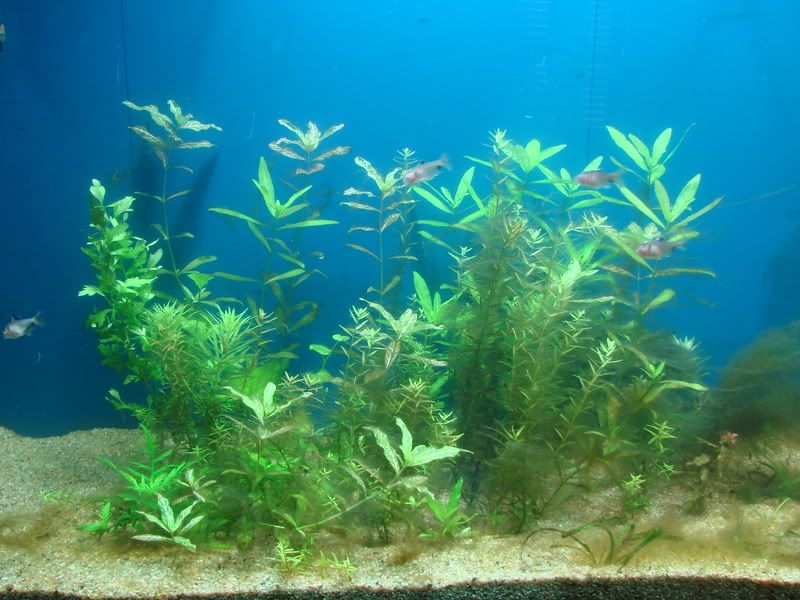
Common Name: Rotala rotundifolia, Dwarf rotala, Rotala indica
Scientific Name: Rotala rotundifolia
Local Name: Rotala rotundifolia, Dwarf rotala, Rotala indica
Origin: Southeast Asia
Native to Philippines (Y/N):
Light Level: High to Very High
CO2 Requirement (Y/N): Y
Fertilizer Requirement (Y/N): Y
Life Span:
Freshwater/Brackish/Marine: Freshwater
Water pH: 5 - 8
Water Hardness:
Common Illness/Problems:
Growth: Fast
Length/Size: 40 - 60 cm
Difficulty: Easy
Tank Position: Mid-ground to Background
Water Current/Movement Issues:
General Description:
The Latin name means ‘’the plant with the round leaves’’. But this only applies to the marsh variety, which has circular leaves. In aquariums Rotala rotundifolia has long, thin leaves. Unlike other Rotala-species it is relatively undemanding, although it needs good light to produce red leaves. It forms side shoots willingly, becoming compact and bushy. This also means that it is hard for light to reach the lower leaves, so the plant should be pruned frequently. Also known as Rotala indica.
Other Important Information:
Flora #60: Heteranthera zosterifolia

Common Name: Heteranthera zosterifolia, Star grass
Scientific Name: Heteranthera zosterifolia
Local Name: Heteranthera zosterifolia, Star grass
Origin: Brazil
Native to Philippines (Y/N):
Light Level: High to Very High
CO2 Requirement (Y/N): Y
Fertilizer Requirement (Y/N): Y
Life Span:
Freshwater/Brackish/Marine: Freshwater
Water pH: 5 - 8
Water Hardness:
Common Illness/Problems:
Growth: Fast
Length/Size: 30 - 50 cm
Difficulty: Easy
Tank Position: Mid-ground to Background
Water Current/Movement Issues:
General Description:
Heteranthera zosterifolia is an extremely beautiful plant which forms a lot of side shoots and thus quickly forms a bushy plant group. In strong light growth is intensive, and the plant must be pruned before it becomes so compact that no light reaches the lower leaves. Water roots often form on the stem. In open aquariums it forms small blue fl owers if some shoots are allowed to spread on the surface.
Other Important Information:
Flora #61: Pogostemon helferi

Common Name: Pogostemon helferi, Daonoi, Little Star
Scientific Name: Pogostemon helferi
Local Name: Pogostemon helferi, Daonoi, Little Star
Origin: Thailand, Burma
Native to Philippines (Y/N):
Light Level: Medium to Very High
CO2 Requirement (Y/N): Y
Fertilizer Requirement (Y/N): Y
Life Span:
Freshwater/Brackish/Marine: Freshwater
Water pH: 6 - 7.5
Water Hardness:
Common Illness/Problems:
Growth: Medium
Length/Size: 2 - 10 cm
Difficulty: Medium
Tank Position: Foreground
Water Current/Movement Issues:
General Description:
This plant was discovered by aquarists in Thailand, close to the border with Burma. It is called ‘Daonoi’ (little star) in Thailand, and it is easy to see why. Pogostemon helferi is an unusual and distinctive aquatic plant with a compact habit, curly leaves and a strikingly beautiful green colour. With good light conditions and a substrate rich in nutrients Pogostemon helferi forms many side shoots, which develop small roots, and the plant rapidly forms an impressive carpet of foreground vegetation. It important to note, however, that herbivorous fi sh appreciate this plant as much as aquarists do.
Other Important Information:Last edited by gaevwa; 12-04-2009 at 09:50 PM.
-
12-04-2009, 09:57 PM #40
Fauna #11 : Cardinal Tetra
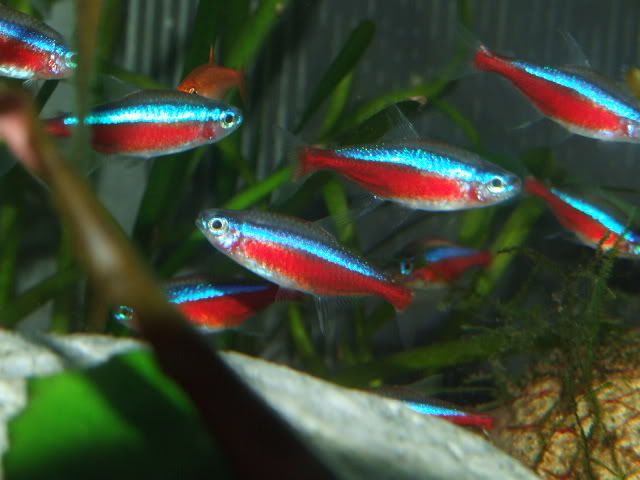
Common Name: Cardinal Tetra
Scientific Name: Paracheirodon axelrodi
Local Name: Cardinal Tetra, rainbow fish
Origin: Orinoco and Negro Rivers in South America
Life Span:
Temperament: Peaceful, Docile
Tank Compatibility Issue (for both Flora and Fauna): Peaceful fishes, several aquatic plants
Freshwater/Brackish/Marine: Freshwater
Water pH: 5.3-7.8
Water Hardness: soft,acidic water
Schooling/Non-schooling: Schooling
Common Illness/Problems:Ich, Fungi ,Bullying, Predation, Stress and polluted tank.
Growth: fast, depends on diet
Length/Size:3 cm (1.25 in)
Difficulty: Easy to Medium
Water Current/Movement Issues:Given the origins of the cardinal tetra, namely blackwater rivers whose chemistry is characterised by an acidic pH, low mineral content and the presence of humic acids, the species is adaptable to a wide range of conditions in captivity, though deviation from the soft, acidic water chemistry of their native range will impact severely upon breeding and fecundity.
Description: The cardinal tetra is a very popular aquarium fish but is less widespread than the neon tetra because until recently it was difficult to breed in captivity. However, many breeders are now producing the fish; in most cases one can determine if the cardinal tetra is bred or wild caught due to damaged fins on wild caught specimens. Normally aquarists prefer to buy tank bred fish but some Brazilian ichthyologists believe that fishkeepers should continue to support the sustainable Cardinal fishery of the Amazon basin, since thousands of people are employed in the region to capture fish for the aquarium trade. It has been suggested that if those fishermen lost their livelihood catching Cardinals and other tropical fish, they might turn their attention to engaging in deforestation.
Other Important Information:
The cardinal tetra, in the wild, swims upstream in large numbers to parts of its native river habitat that are completely enclosed above by rainforest canopy. Such waters are subject to heavy shading by the rainforest trees, and virtually no sunlight reaches them. Here, the fishes spawn in large aggregations. In the aquarium, a single pair can be conditioned for breeding, but the breeding aquarium not only needs to contain water with the correct chemical parameters cited above: the breeding aquarium needs to be heavily shaded to mimic the low light conditions of the fish's native spawning grounds. If the fishes are ready to spawn, the male, which will be the slimmer of the two fishes in outline, will pursue the female into fine-leaved plants: her fuller outline, which usually indicates the presence of ripe eggs within her reproductive tract, should be readily apparent at this point. If the female is ready, she will allow the male to swim alongside her, and together, the pair will release eggs and sperm.
Apart from the stringent requirements with respect to water chemistry, one of the major difficulties mitigating against success in captive breeding of the species is the nature of the newly laid and fertilised eggs. The eggs of the cardinal tetra are photosensitive, and will die if exposed to bright light. Consequently, after spawning, the fishes should be removed and the aquarium covered to darken it, thus providing the developing eggs with the conditions necessary for development.If the eggs are fertile, and kept in darkened surroundings, they will hatch in approximately 3 days at 28°C. Free swimming fry remain photosensitive for at least the first 7 days of life, and need to be introduced to increasing light levels on a gradual basis. During this time, they are approximately 4 mm in length, and require infusoria or liquid fry food. Newly hatched brine shrimp and other similar live foods such as sifted Daphnia can be fed to the growing fry at between 7 and 14 days of age. Growth continues at a modest rate, and the fishes assume full adult colouration only after a period of approximately 8 to 12 weeks, depending upon quality of food and aquarium water.
The characteristic iridescence of this and related fishes such as the neon tetra is a structural colour, caused by refraction of light within guanine crystals that develop within special cells called iridocytes in the subcutaneous layer. The exact shade of blue that is seen will depend upon the viewing angle of the aquarist relative to the fish - if the aquarist changes viewpoint so as to look at the fish from the substrate upwards, the colour will change hue, becoming more deeply sapphire blue and even indigo. Change the viewpoint to one above the fishes, however, and the colour becomes more greenish.Most tetras will fade in color if they are stressed or uncomfortable with their surroundings. (But note that many lose all their color at night, which is not a cause for alarm).The cardinal tetras is often confused with the neon tetra but they are two distinct fish. The cardinal has more red on it's bottom half however. The two fish species can be kept together so there is no reason why they cannot be mixed in the aquarium.
Feed them on a general community or tetra flake mix. They will also appreciate frozen bloodworms from time to time.
References :
Cardinal Tetra
Cardinal tetra - Wikipedia, the free encyclopedia
Cardinal tetra image by auifish on Photobucket
HowStuffWorks "Cardinal Tetra"
cardinal tetra - Hanapin sa Google
Advertisement
Similar Threads |
|




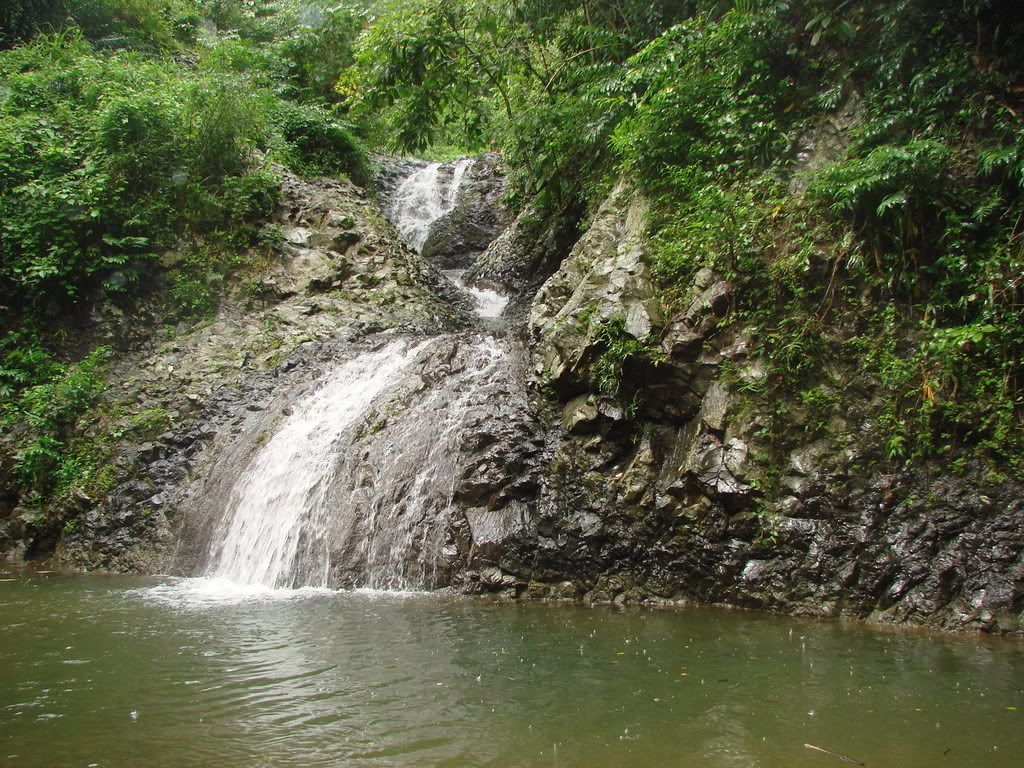


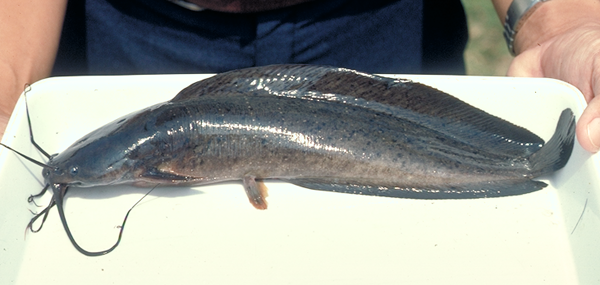


 Reply With Quote
Reply With Quote



